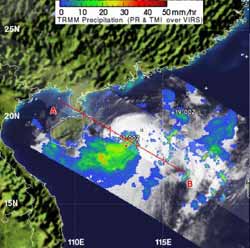NASA reveals heaviest rainfall in Tropical Storm Talim's southwestern side

NASA's TRMM satellite captured a look at rainfall occurring in newborn Tropical Storm Talim in the South China Sea on June 18, 2012 at 0331 UTC. Areas in blue and green represent light to moderate rainfall, falling at a rate between 0.78 and 1.5 7inches (20-40 mm) . The bulk of the rainfall was occurring on the southern and western quadrants of the storm. Credit: Credit: NASA/SSAI, Hal Pierce<br>
NASA's Tropical Rainfall Measuring Mission (TRMM) satellite captured a look at rainfall occurring in newborn Tropical Storm Talim in the South China Sea on June 18, 2012 at 0331 UTC. Areas in blue and green represent light to moderate rainfall, falling at a rate between 0.78 and 1.5 7inches (20-40 mm). Some of the thunderstorms near the center of circulation were approaching 10 kilometers (6.2 miles) high.
NASA's Aqua satellite passed over Talim on June 18 at 0617 UTC (2:17 a.m. EDT), and captured infrared data about its cloudtop temperatures. Data showed that the western quadrant of the storm extended over Vietnam, bringing some rainfall there today, June 18.
The strongest thunderstorms, however, were still off-shore at the time, where cloud top temperatures exceeded -63F (-52C), and that's where the heaviest rainfall was occurring.
Forecasters expect that today's brush with Vietnam will be its only encounter with that country, as Talim is now heading northeast, and toward Taiwan. On June 18, 2012 at 1200 UTC (8 a.m. EDT/U.S.) maximum sustained winds were near 45 knots (52 mph/83 kph). Talim was crawling to the northeast at 3 knots (3.4 mph/5.5 kph) and is currently 185 nautical miles (213 miles/342.6 km) south-southwest of Hong Kong.
Sea surface temperatures in the South China Sea are warm enough to keep Talim going and forecasters expect Talim to strengthen on its journey to the northeast. Talim is expected to reach the Taiwan Strait in two days.
Media Contact
More Information:
http://www.nasa.govAll latest news from the category: Earth Sciences
Earth Sciences (also referred to as Geosciences), which deals with basic issues surrounding our planet, plays a vital role in the area of energy and raw materials supply.
Earth Sciences comprises subjects such as geology, geography, geological informatics, paleontology, mineralogy, petrography, crystallography, geophysics, geodesy, glaciology, cartography, photogrammetry, meteorology and seismology, early-warning systems, earthquake research and polar research.
Newest articles

A universal framework for spatial biology
SpatialData is a freely accessible tool to unify and integrate data from different omics technologies accounting for spatial information, which can provide holistic insights into health and disease. Biological processes…

How complex biological processes arise
A $20 million grant from the U.S. National Science Foundation (NSF) will support the establishment and operation of the National Synthesis Center for Emergence in the Molecular and Cellular Sciences (NCEMS) at…

Airborne single-photon lidar system achieves high-resolution 3D imaging
Compact, low-power system opens doors for photon-efficient drone and satellite-based environmental monitoring and mapping. Researchers have developed a compact and lightweight single-photon airborne lidar system that can acquire high-resolution 3D…





















